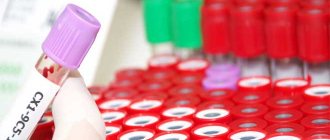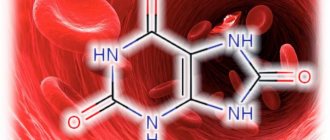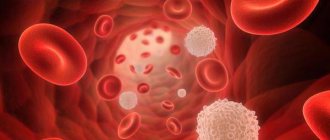You are here: Blood test -
Leukocytes in the blood -
Low white blood cells in a child's blood
- Norm and reasons for deviation
- Classification
- Symptoms
- Diagnostics
- Treatment
- Possible complications
- Prevention and prognosis
Low leukocytes in the blood of a child (syn. leukopenia) is a disorder in which there is a decrease in the concentration of white blood cells in the main biological fluid of the human body. It is noteworthy that normal values will differ slightly depending on age. Thus, the level in the blood of a newborn will differ from that of older children.
In the vast majority of cases, pathological factors provoke the development of such a disorder. However, there are several physiological reasons that are not related to the course of a particular disease.
A decrease in leukocytes in the blood can be indicated by characteristic symptoms, for example, headaches, increased heart rate, increased temperature and many other manifestations. Moreover, they can be veiled under the symptoms of a provoking disease.
It is possible to establish the presence of a shift in the leukocyte formula only after deciphering a general clinical blood test. However, additional laboratory and instrumental examinations may be needed to determine the cause.
This condition in children can be corrected using conservative therapeutic methods - by taking medications, following a special diet and using traditional medicine recipes.
Indicators of the norm and reasons for deviation
The normal levels of leukocytes, as well as components that belong to this group, such as neutrophils, monocytes, basophils and eosinophils, in a child’s blood will change with age.
| Age category | Norm (x 10^9/l) |
| Newborns | 8.5-25 |
| 1 month | 6.5-13 |
| Six months | 5.5-12.5 |
| 1 year | 6-12 |
| From 2 years | 6-11.4 |
| 5-10 years | 5.2-11 |
| Over 10 years old | 4.5-10 |
| From 15 years old | 9-10 |
It follows from this that if, during a general clinical blood test, values below normal are detected, then hematologists will diagnose leukopenia. It should be borne in mind that the concentration of white blood cells does not depend on gender.
The main reason why leukocytes in a child’s blood are low is often due to one of the following diseases:
- aplastic and B12-deficiency anemia;
- leukemia in acute form;
- radiation sickness;
- acute allergic reaction;
- anaphylactic shock;
- a wide range of autoimmune diseases;
- any bone marrow damage;
- diabetes;
- hypothyroidism and other pathologies of the endocrine system;
- chicken pox and measles;
- brucellosis and hepatitis;
- rubella and tuberculosis;
- malaria and mumps;
- sepsis and AIDS;
- hypovitaminosis and hypotension;
- rheumatoid arthritis;
- systemic lupus erythematosus;
- Kostman's syndrome;
- hyperfunction of the spleen;
- dysfunction of the pancreas;
- purulent damage to soft tissues and the skeletal system;
- multiple myeloma;
- HIV infection;
- renal failure.
Less harmless root causes, that is, not related to the course of a particular illness, are presented:
- postoperative period;
- long-term chemotherapy or radiotherapy;
- penetration of heavy metals into the body;
- insufficient intake of vitamins, folic acid, iron and zinc, ascorbic acid, selenium and iodine, proteins and other nutrients (in such cases, red blood cells and platelets will also be reduced);
- drug overdose;
- improper nutrition.
Regardless of the cause, in any situation it is best to start treatment as soon as possible, which will avoid the formation of undesirable consequences.
Norm and leukopenia
What do elevated neutrophils mean?
The center of the neutrophil has a grain containing a complex of enzymes to destroy bacteria and deactivate their toxins. The tasks of neutrophils in the blood:
- infect foreign microbial cells;
- accompany the body's inflammatory reactions.
50-70% of the total number of leukocytes is considered normal. The normal absolute content of neutrophil elements for children of different ages is presented in the table.
An increased level of neutrophils in the blood relative to the norm means the body is fighting an infectious agent - bacteria or fungi. Elevated neutrophils indicate that further examination is necessary to identify the cause of neutrophilia and isolate the causative agent of the disease.
Segmented
There are simultaneously neutrophils of varying degrees of maturity in the blood. Segmented neutrophils are a mature form, ready to destroy bacteria and fungi. They show divisions between segments of the nucleus.
The indicators of segmented forms in the leukogram of healthy children are shown in the table.
Increased segmented neutrophils are considered a shift of the leukocyte formula to the right . If segmented neutrophils are elevated, this indicates a bacterial or fungal infection, a mild inflammatory process. When there is no infectious threat, the full life cycle of a neutrophil lasts about 14 days, and then it is destroyed in the spleen. When infected, one segmented neutrophil destroys 5-7 microbes and dies.
Increased mature cells with a nucleus having more than 5 segments suggest kidney and liver disease, radiation sickness, and recent blood transfusion. Increased segmented forms with increased granularity of the nucleus, vesicles (vacuoles) of the cytoplasm indicate inhibition of bone marrow function.
Neutrophils under a microscope
Rod
Neutrophil cells are born in the red bone marrow and go through successive stages of development:
- Myelocyte is the earliest form of maturation;
- Metamyelocyte or juvenile cell;
- Band neutrophil;
- Segmented neutrophil.
The nuclei of rod cells do not have fragmentary divisions. When viewed under a microscope, the nuclei of immature leukocytes look like rods. There are relatively few rod elements in the analysis of a healthy child. The normal percentage ratio of band neutrophils to the total number of leukocytes:
- newborn children – 3-12%;
- from 5 days and older – 1-5%.
An increased percentage of band forms in the blood is called a shift of the leukogram to the left. This means that the child has an acute bacterial or fungal infection.
When the level of band neutrophils in the analysis is increased, this indicates that it is difficult for the body to cope with the infectious-inflammatory process. The main cause of increased band cells is serious microbial infection. To help mature segmented cells, young band leukocytes are released from the reserve to fight the infectious agent.
Symptoms
Some clinical manifestations may indicate a decrease in leukocytes, however, this condition most often occurs completely asymptomatically. In addition, the peculiarity of this disorder is that its symptoms can be veiled under the external signs of the underlying illness.
It is very difficult to detect a decrease in the concentration of white blood cells in the main biological fluid of an infant without a blood test. This is due to the fact that infants cannot describe their anxieties and sensations in words.
However, with leukopenia the following symptoms may occur:
- increase in temperature indicators;
- increased heart rate;
- severe chills;
- dizziness;
- causeless anxiety;
- prolonged headaches;
- weakness and weakness;
- increased volume of lymph nodes;
- splenomegaly – an increase in the size of the spleen;
- hoarseness of voice;
- aversion to food;
- weight loss, even to the point of exhaustion;
- bleeding gums;
- learning problems in older children.
It must be taken into account that the above are only general symptoms, which can be supplemented by signs that are most characteristic of a particular underlying disease.
Types of lymphocytopenia
Depending on the reason that provoked a decrease in the level of lymphocytes in the peripheral blood, lymphocytopenia can be:
- Absolute. This decrease in lymphocytes is mainly due to insufficient production of white blood cells in the bone marrow. It is diagnosed in congenital or acquired immunodeficiencies, leukemia, chronic liver pathologies and in other cases. The appearance of this type of lymphopenia in a newborn poses a great danger to the baby’s life and can lead to death.
- Relative. It is caused by an increase in the number of neutrophils (neutrophilia). Most often, such lymphopenia is caused by acute or chronic infection.
Lymphocytopenia is also divided into:
- Congenital. It is caused by various congenital pathologies or diseases transmitted to the baby in utero from the mother.
- Acquired. This decrease in lymphocytes is due to the child’s exposure to various factors after birth, for example, drugs, toxic substances or viruses.
Diagnostics
Reduced leukocytes in a child’s blood are determined only during a general clinical examination of the main biological fluid. This laboratory test may require both capillary and venous biological material.
Patients are required to undergo simple preparation for such a diagnosis, which consists of refusing to eat at least 4 hours before visiting a medical facility. Otherwise, the results may be false positive, which may require repeated blood donation, which is undesirable for the child.
The information obtained from such a laboratory test cannot accurately indicate the reasons why children have low white blood cells. To identify any of the above primary sources, a comprehensive examination of the body will be required.
The first step of diagnosis includes manipulations carried out directly by the clinician, namely:
- reviewing the medical history to look for underlying acute or chronic pathology;
- collection and analysis of life history to confirm or refute the fact of the influence of sources not related to the course of any disease;
- measuring temperature and heart rate;
- deep palpation and percussion of the anterior wall of the abdominal cavity - this will help identify splenomegaly;
- a detailed survey of the patient or his parents to obtain data on the clinical picture.
Splenomegaly
Additional diagnostic methods include specific laboratory tests, instrumental procedures, as well as consultations with specialists from various fields of medicine.
Analysis of urine
No less informative is a urine test. It is taken both during routine medical examinations and to assess health status during illness. The indicators that are assessed during the analysis are:
- color - golden or straw yellow;
- transparency - normally urine is always clear;
- density - 1010-1024 g/l;
- foaminess - when shaken, an unstable transparent foam is formed;
- smell - corresponds to the disease, for example, with phenylketonuria, the smell of mouse urine;
- acidity - PH 5.0-7.0;
- the presence of protein is considered a deviation from the norm of more than 0.033 g/l.
Treatment
A low white blood cell count cannot be eliminated without treating the underlying disease. Each patient's treatment tactics will be individual, however, the general principles can be conservative or surgical. Very often, treatment of a provoking disease takes an integrated approach.
Drug treatment is aimed at increasing the production of white blood cells.
This is achieved by taking the following medications:
- "Leukogen";
- "Methyluracil";
- "Pentoxyl";
- "Lenograstim";
- "Filgrastim";
- "Sargramostim."
Additionally, you will need to use vitamin complexes.
Patients are advised to change their diet and enrich their diet with the following foods:
- dietary varieties of meat and fish;
- offal and seafood;
- greens and fresh vegetables;
- legumes;
- dairy and fermented milk products;
- buckwheat, rice, oatmeal and corn porridge, wheat;
- nuts and dried fruits;
- homemade honey and jam;
- green tea.
You should avoid fatty and spicy foods, as well as ingredients with dyes and preservatives.
Traditional medicine recipes are used as a complement to the above methods, and not as the main method of therapy.
After the approval of the attending physician, it is allowed to prepare medicinal drinks at home based on:
- oats;
- wormwood;
- motherwort;
- horsetail;
- rosehip;
- aloe.
Such treatment is prohibited if there is a decrease in leukocytes in the blood of a newborn and children under 2 years of age.
Possible complications
Parents’ refusal of qualified help, their ignoring of symptoms and independent attempts to get rid of such pathology are fraught with the development of the following diseases:
- anemia;
- thrombocytopenia;
- stomatitis;
- pneumonia;
- liver abscess;
- agranulocytosis;
- aleukia;
- a decrease in the resistance of the immune system, which makes the child often susceptible to infectious diseases.
The risk of developing cancer also increases significantly.
Prevention and prognosis
A decrease in leukocytes in a child’s blood can be prevented by following simple preventive measures. The patient's parents should monitor their implementation.
First of all, it is necessary to prevent the formation of the above pathological etiological factors. For this, the child should be regularly shown to a pediatrician, and, if necessary, undergo examination by specialists from other fields of medicine.
Additional prevention recommendations are:
- maintaining an active lifestyle;
- good nutrition;
- constant strengthening of the immune system;
- taking only those medications prescribed by the attending physician, with mandatory adherence to the daily dosage and duration of use;
- preventing chemicals and toxic substances from entering the child’s body.
In itself, a decrease in the level of leukocytes is not a threat to the child’s life. Pathological provocateurs of this condition pose a danger. A complete lack of treatment will lead not only to the above-mentioned consequences, but also to complications of the provoking disease.
Increased ESR in a child
When a small child has complaints about his health and there is a suspicion of the presence of an inflammatory or infectious process, then in this case it is necessary to consult a pediatrician.
After a preliminary examination, you should be given a referral for a blood test.
Blood test for ESR
is necessary to determine 2 indicators such as: ROE (erythrocyte sedimentation reaction), as well as ESR (erythrocyte sedimentation rate). Thanks to the resulting values, it will be possible to say whether there is an inflammatory process in the child’s body or not.
The ESR indicator means how quickly red blood cells begin to stick to each other (for this a special chemical reaction is carried out).
But, remember that it is impossible to make one or another diagnosis for a child based on just one ESR indicator. It is imperative to undergo further clinical examination. And only after this, it will be possible to draw certain conclusions.
The reasons for an increase in ESR can be quite different, ranging from a common cold to minor neuro-emotional stress.











